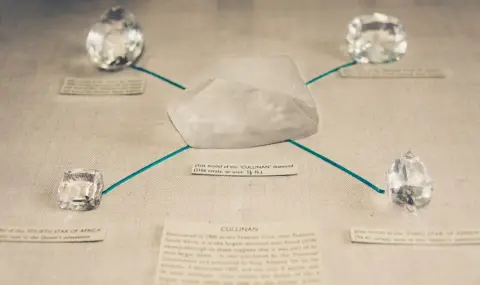On January 26, 1905, the largest diamond in the world, the Cullinan, was discovered in the Premier Mine in the former British colony of the Transvaal (now a province in South Africa). Its discovery was by pure chance. The head of one of the mines at the Premier Mine, Frederick Wells, went out for a walk in the fresh air (since the incident took place at night, in some places the date is given as January 25). In the moonlight, he noticed a flash on the wall of the mine. Workers were immediately called in to dig around the site and pull out the giant diamond weighing 621 grams (3,106 carats) from the rocks, recalls "In Brief".
The curious thing is that later the specialists found out that the stone was once part of a larger crystal. But even after thoroughly sifting everything around the place where it was discovered, they failed to find any other fragments. According to another version, the stone was accidentally stumbled upon by workers who were digging a well for water. But this is more of an urban legend.
They named the giant Cullinan – after the owner of the mine.
The Transvaal government decided to buy the rough diamond and present it to the King of the British Empire, Edward VII. However, the question arose of its safe transport to England. At that time, the diamond was valued at 8 million pounds sterling (equivalent to today's prices, it would be worth as much as 94 tons of gold). Cullinan would have been a desirable prey for any thief. The British found a simple but effective solution to the problem.
They prepared a warship, provided it with a crew armed to the teeth. A massive safe was placed in the hold of the ship, and the preparation of the ship itself was monitored and reflected in the pages of British newspapers. However, all this was a walk at sea on an empty safe. Cullinan was transported to England as an ordinary postal item on a normal postal ship. Only the senders of the item and the recipients of the diamond knew that the stone was being transported in this way.
The processing of the stone was entrusted to the best engraver in Europe at that time - Josef Asker. He studied the diamond for several months and only then did the actual cutting and polishing begin. Rumor has it that when the jeweler placed the chisel in the place where he thought he should split the stone and struck the first blow on it, he lost consciousness from the excitement that seized him.
After splitting the diamond, 9 larger pieces were obtained. The largest after processing was called the “Great Star of Africa” (or “Cullinan I”). It weighed 516.5 carats (103.3 grams). It was inlaid in the scepter of Edward VII and was so made that it could be separated from the scepter and worn separately as a brooch.
The second largest piece was turned into the diamond “Cullinan II” and is encrusted in the Crown of the British Empire, just below the "Black Prince" ruby on the crown's front cross.
The remaining larger pieces were also made into jewelry, receiving consecutive numbers in the name Cullinan. About a hundred more diamonds were made from the smallest remnants.
